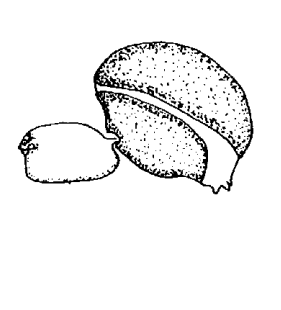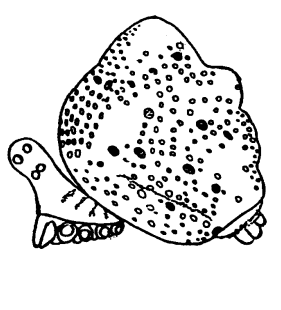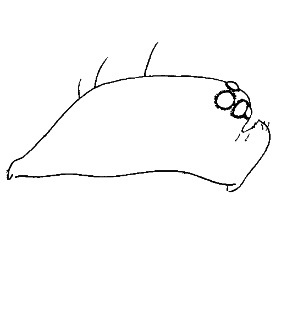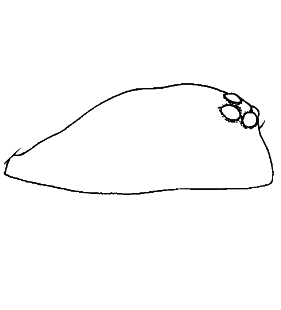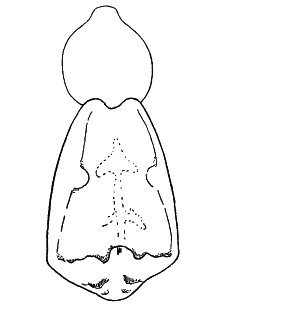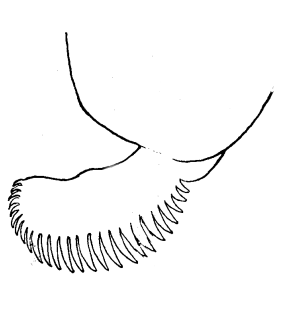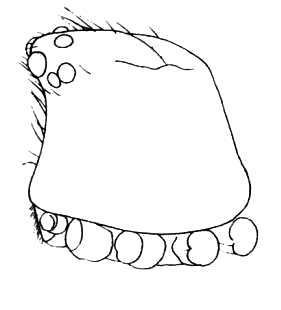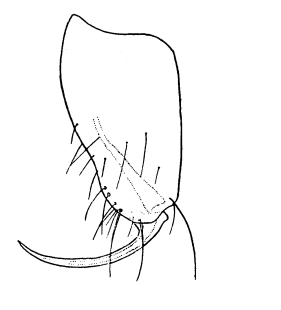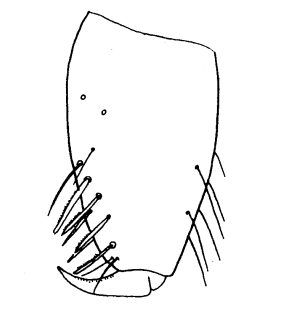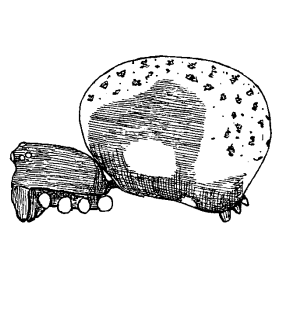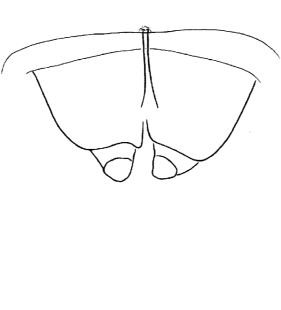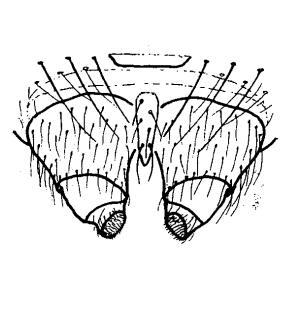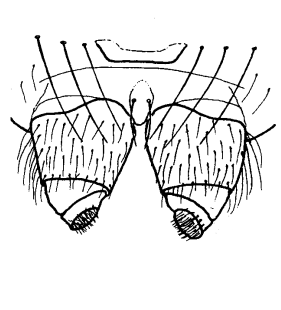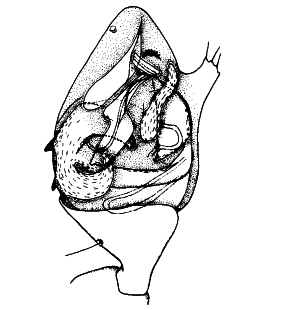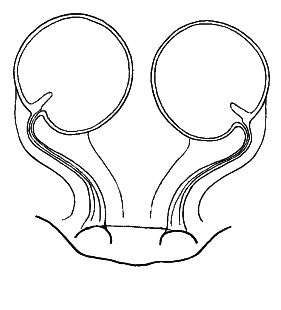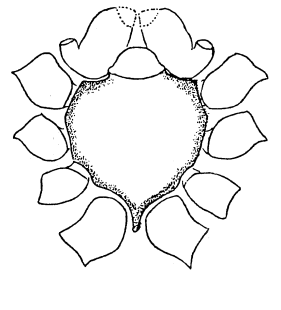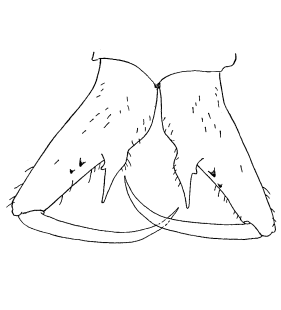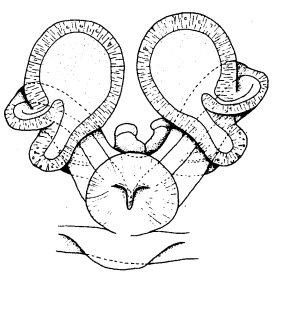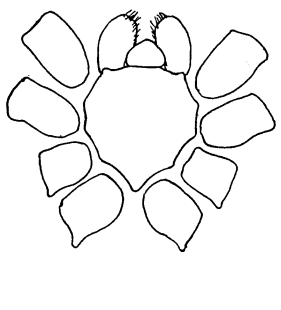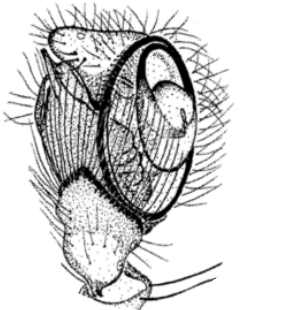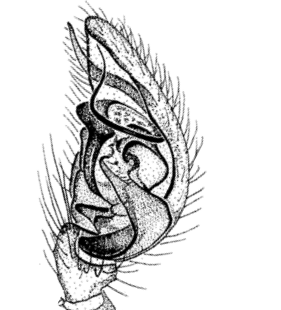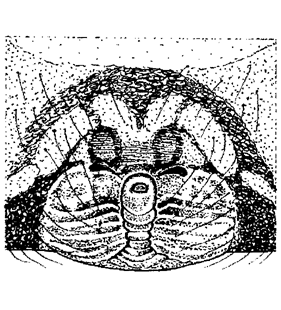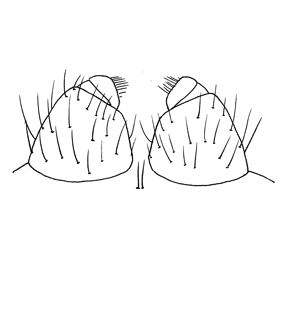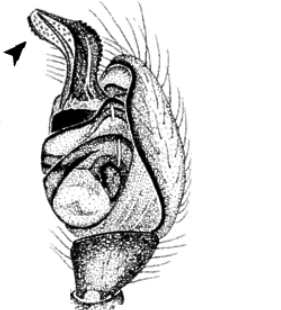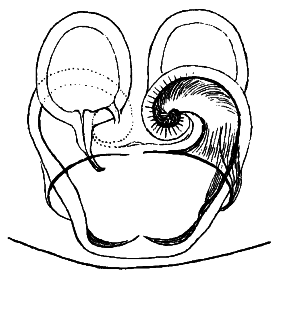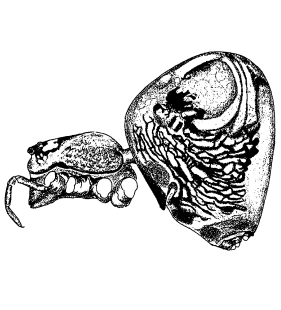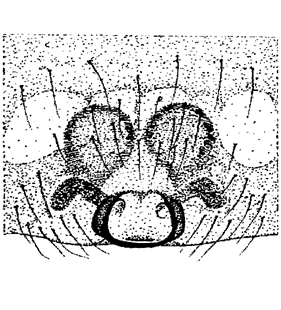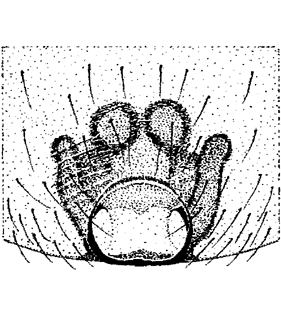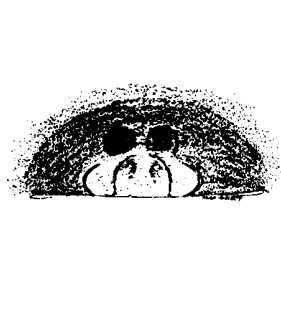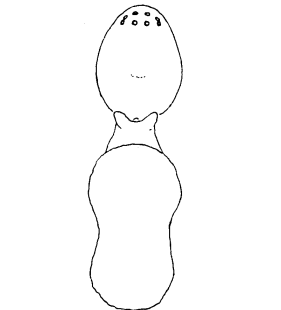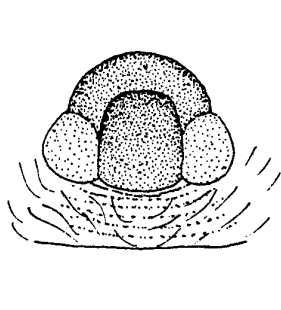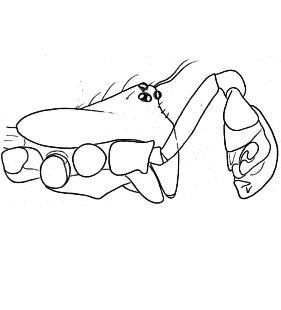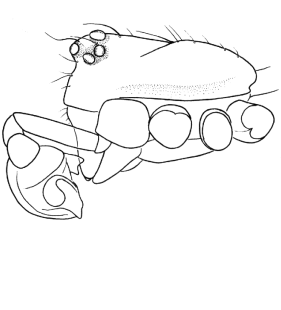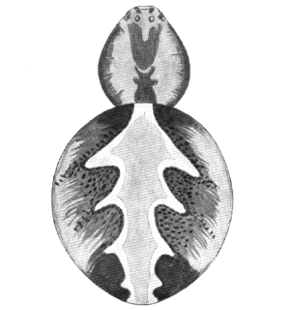Familie Theridiidae Sundevall, 1833
Schlüssel nicht vollständig. Weitere Gattungen sind am Ende aufgelistet. |
Für Fehlermeldungen oder Verbesserungsvorschläge bitte Link folgen: click
|
|||||||
| 1 |
Tarsen der 1. Beine angeschwollen |
|||||||
| - | Tarsen alle gleich und nicht angeschwollen |
|||||||
| 2 (1) |
Vordere Mittelaugen kleiner als die übrigen Augen |
|||||||
| - | Vordere Mittelaugen grösser, Augen in zwei Reihen, Männchen ohne Scutum |
|||||||
| 3 (2) |
Vordere Mittelaugen sehr klein, die übrigen in zwei Gruppen beieinander, männliches Opisthosoma mit Scutum, Körperlänge 1.2-1.5 mm |
| ||||||
| - | Vordere Mittelaugen kleiner als die übrigen, Augen eng zusammenstehend, halbkreisförmig, Opisthosoma ohne Scutum, oval, jedoch etwas länger als breit, Männchen schlank |
|||||||
| 4 (2) |
Vordere und hintere Seitenaugen mindestens durch ihren Durchmesser voneinander getrennt |
|||||||
| - | Seitenaugen sich fast berührend oder kaum voneinander getrennt |
|||||||
| 5 (4) |
Tarsen länger als Metatarsen oder gleich lang, kleine Spinnen, Körperlänge 1-2 mm |
|||||||
| - | Tarsen kürzer als Metatarsen, Körperlänge grösser als 1.5 mm |
|||||||
| 6 (5) |
Opisthosoma sklerotisiert, mit Höckern |
| ||||||
| - | Opisthosoma nicht sklerotisiert, gerundet |
|||||||
| 7 (6) |
Männlicher Clypeus mit konischem Vorsprung; Weibchen unbekannt |
| ||||||
| - | Clypeus nicht modifiziert |
| ||||||
| 8 (5) |
Männchen mit auffälligen Stirnfortsätzen, Opisthosoma konisch ausgezogen, Südeuropa |
|||||||
| - | Männchen ohne Stirnfortsätze, Opisthosoma anders |
|||||||
| 9 (8) |
Grundfärbung hellbraun, Opisthosoma einheitlich hellbraun, ohne Fleckung, in langem Fortsatz ausgezogen |
|||||||
| - | Opisthosoma nicht in langem Fortsatz ausgezogen |
|||||||
| 10 (9) |
Grundfärbung dunkelbraun, Opisthosoma mit leuchtend weissen Guaninflecken |
|||||||
| - | Grundfärbung einheitlich hellbraun, Opisthosoma abgestutzt, in mehreren Höckern endend |
|||||||
| 11 (8) |
Opisthosoma in Weibchen breiter als lang, mit seitlichen Vorsprüngen, glänzend, leuchtend schwarz gelb oder einheitlich schwarz gefärbt (ausgenommen Theridula aelleni) |
|||||||
| - | Anders |
|||||||
| 12 (11) |
Opisthosoma länglich, deutlich länger als breit, dreieckig, gestutzt, beim Männchen schlank |
| ||||||
| - | Opisthosoma sphärisch oder von anderer Gestalt |
|||||||
| 13 (12) |
Prosoma hoch. Cheliceren kurz, vordere Mittelaugen meist grösser als hintere Mittelaugen, weiblicher Pedipalpus mit kammartiger Kralle, Weibchen mit vier Receptacula |
| ||||||
| - | Prosoma vergleichsweise flach, Cheliceren lang, vordere Mittelaugen nicht grösser als hintere Mittelaugen, Kralle des weiblichen Pedipalpus nicht modifiziert, Weibchen mit zwei Receptacula |
|||||||
| 14 (13) |
Opisthosoma zugespitzt, Spinnwarzen von dorsal sichtbar, Chelicerenklauen lang, Trichobothrium an Metatarsus I bei 0.8-0.9 |
| ||||||
| - | Opisthosoma gerundet, über Spinnwarzen vorragend, Spinnwarzen daher von dorsal nicht sichtbar, Chelicerenklauen meist kurz, Trichobothrium an Metatarsus I bei 0.3-0.5, nur bei Dipoena braccata 0.7 (Trichobothrium schwer erkennbar)
inkl. nachfolgende Gattungen |
| ||||||
| - | ||||||||
| - | ||||||||
| - | ||||||||
| - | ||||||||
| 15 (13) |
Colulus deutlich vorhanden oder invaginiert und durch zwei Setae vertreten |
| ||||||
| - | Colulus fehlt |
|||||||
| 16 (15) |
Colulus gross und deutlich sichtbar, weibliche Cheliceren mit 0-2 Zähnen am hinteren Klauenfurchenrand |
|||||||
| - | Colulus invaginiert, nur noch durch zwei Setae erkennbar, weibliche Cheliceren mit 4 Zähnen am hinteren Klauenfurchenrand |
|||||||
| 17 (16) |
Prosoma rau |
|||||||
| - | Prosoma glatt |
|||||||
| 18 (17) |
Sternum vergleichsweise breit und hinten abgestutzt, Cymbium des männlichen Pedipalpus mit prolateralem Vorsprung, Cheliceren in beiden Geschlechtern ähnlich, Körperlänge 2-3 mm, Colulus deutlich sichtbar, mit zwei Setae besetzt |
| ||||||
| - | Sternum hinten spitz zulaufend, Cymbium nicht modifiziert, männliche Cheliceren oft vergrössert, Körperlänge mitteleuropäischer Vertreter 3.5-13.0 mm, Colulus gross mit sechs bis acht Setae |
|||||||
| 19 (18) |
Körperfärbung markant, Opisthosoma dunkel mit gelber Flecken bzw. Zeichnung, Femora der Männchen verdickt und ventral bedornt |
|||||||
| - | Körperfärbung anders, Femora der Männchen ventral nicht bedornt |
|||||||
| 20 (17) |
Sternum zwischen Coxae IV vorgezogen, Opisthosoma oft mit dorsalem Muster (ausser E. thoracica), männliche Cheliceren stark vergrössert, mit deutlichen Zähnen, weibliche Cheliceren mit einem Zahn am hinteren Klauenfurchenrand, Receptacula seminis gleichmässig gerundet |
| ||||||
| - | Sternum nicht zwischen Coxae IV vorgezogen, Opisthosoma einfarbig grau bis braun, Cheliceren in beiden Geschlechtern ähnlich, Cheliceren mit zwei Zähnen am hinteren Klauenfurchenrand, Receptacula seminis posterior verengt |
| ||||||
| 21 (16) |
Männlicher Taster mit auffallender Beborstung, Epigyne unscheinbar, ohne Scapus, Südeuropa |
| ||||||
| - | Beborstung des männlichen Tasters anders, Epigyne mit Scapus |
| ||||||
| 22 (15) |
Opisthosoma höher als lang |
|||||||
| - | Opisthosoma nicht höher als lang |
|||||||
| 23 (22) |
Opisthosoma mit dorsalem Höcker oder konisch |
|||||||
| - | Opisthosoma ohne dorsalen Höcker, abgerundet |
|||||||
| 24 (23) |
Klein, Körperlänge 1.2-1.6 mm, dunkel gefärbt, mit unregelmässigem Muster aus hellen Flecken |
|||||||
| - | Grösser, Körperlänge 1.7-4.1 mm |
|||||||
| 25 (24) |
Helle Körperfärbung, Opisthosoma konisch ausgezogen, mit weissem oder dunklem Streifenmuster oder auffälligen Stachelborsten |
|||||||
| - | Körperlänge1.7-3.2 mm, Körperfärbung hell oder dunkelbraun, Opisthosoma mit unscheinbarem Höcker und mit heller Fleckung, in Mitteleuropa eingeschleppt, in Gewächshäusern |
|||||||
| 26 (23) |
Konduktor überragt Cymbium deutlich, Epigynengrube gross |
| ||||||
| - | Konduktor überragt Cymbium nicht, Epigynengrube bzw. Einführungsöffnungen klein, unscheinbar |
|||||||
| 27 (22) |
Tibiae I-IV mit 1/1/1/1 Setae |
|||||||
| - | Abfolge der Setae an Tibiae I-VI anders, meist 2/2/1/2 |
|||||||
| 28 (27) |
Trichobothrium an Metatarsus III vorhanden, Position des Trichobothrium an Metatarsus I-II auf ca. 0.9-0.95, Körperfärbung hellgelb mit schwarzer Sprenkelung |
|||||||
| - | Trichobothrium an Metatarsus III fehlend, Grundfärbung meist rot-orangebraun, Opisthosoma mit dorsaler gezackter Foliumzeichnung |
|||||||
| 29 (27) |
Beine, Prosoma und Opisthosoma mit langen, abstehenden Borsten, Metatarsen dorsal-basal mit einer langen Borste, auf den hinteren Beinen länger, männlicher Taster gross und sehr markant, mit stark sklerotisiertem, gewundenem Embolus, Südeuropa |
|||||||
| - | Beborstung von Beinen und Körper unscheinbarer, Metatarsen dorsal-basal ohne lange Borste |
|||||||
| 30 (29) |
Sternum hinten breit, Coxae IV damit weit getrennt, Tibiae I-IV mit 2/1/1/1 Setae, Metatarsus III ohne Trichobothrium, Körperlänge 1.2-2.0 mm, Beine relativ kurz |
|||||||
| - | Sternum hinten zugespitzt, Metatarsus III mit Trichobothrium, Körperlänge der Weibchen und Männchen 2-4 mm, Beine länger |
|||||||
| 31 (30) |
Grundfärbung hellgelb bis hellbraun, manchmal mit Scheckung |
| ||||||
| - | Grundfärbung leuchtend rotbraun, Südeuropa |
|||||||
| 32 (30) |
Tibiae I-IV mit 2/2/1/1 Setae, Körperlänge der Weibchen und Männchen 2.5-3.0 mm, Grundfärbung gelb-rötlich, Opisthosoma dorsal mit ausgedehnter schwarzer Fläche, männlicher Pedipalpus sehr voluminös |
|||||||
| - | Tibiae I-IV mit 2/2/1/2 Setae. Körperlänge der Weibchen und Männchen 2-4 mm |
|||||||
| 33 (32) |
Männliche Cheliceren deutlich verlängert, Tarsenkrallen glatt oder mit wenigen kleinen Zähnen, Epigyne wie Abb. |
| ||||||
| - | Männliche Cheliceren weniger verlängert, Tarsenkrallen mit mehreren grossen Seitenzähnen, Epigyne anders |
|||||||
| 34 (33) |
Männliches Opisthosoma eingeschnürt, anterior ein sklerotisierter Ring, der zwei Lappen bildet, jeder mit Setae, Epigyne wie Abb., in Mitteleuropa eingeschleppt, nur in Gewächshäusern |
| ||||||
| - | Anders |
|||||||
| 35 (1) |
Augenregion des Männchens im Seitenprofil leicht aufgewölbt, mit kurzen Haaren in der Region zwischen den Mittelaugen, Weibchen mit auffallender, vorspringender Epigynengrube, Nordeuropa |
|||||||
| - | Anders |
|||||||
| 36 (35) |
Männliche Tastertibia mit schlankem Auswuchs, männlicher Taster mit voluminösem Subtegulum, Tegulum und zahlreichen Spermophorwindungen, Cymbium mit apikalem, höckerigen Vorsprung, Epigyne wie Abb., Grundfärbung gelb, Männchen mit schwarzer Fleckung |
|||||||
| - | Anders |
|||||||
| 37 (36) |
Trichobothrium an Metatarsi I-II auf 0.6-0.7, Körper einfarbig rötlich-braun; Körperlänge der Männchen 3-4 mm, der Weibchen 4-6 mm; männlicher Pedipalpus und Epigyne wie Abb., in Mitteleuropa eingeschleppt, nur in Gewächshäusern |
| ||||||
| - | Position des Trichobothrium an Metatarsus I-II in basaler Hälfte |
|||||||
| 38 (37) |
Zeichnung des Opisthosoma wie Abb., Grundfärbung gelb bis hellorange-braun, ventral ein schwarzer Fleck vor den Spinnwarzen, Femur des männlichen Tasters basal verdickt und gekrümmt |
| ||||||
| - | Anders |
|||||||
| 39 (38) |
Männlicher Clypeus vorragend, Chelicerenapodeme reichen nicht zu vorderen Mittelaugen, Integument glänzend, wenig behaart, Opisthosoma mancher Arten mit kleinem dorsalem Höcker, Beine lang, schlank, männlicher Epigaster nicht vorspringend, Femur des männlichen Pedipalpus lang (0.7-1.1 mm), Cymbium gross über Bulbus hinausragend |
| ||||||
| - | Männlicher Clypeus nicht vorragend,Chelicerenapodeme reichen beinahe zu den vorderen Mittelaugen, Integument matt, behaart, Beine vergleichsweise kurz, männlicher Epigaster normalerweise vorspringend, Femur des männlichen Pedipalpus kurz (0.3-0.6 mm), Cymbium nicht modifiziert, Opisthosoma oft mit welliger dorsaler Foliumzeichnung
inkl. nachfolgende Gattungen |
| ||||||
| - | ||||||||
| - |
Weitere Gattungen
- 1. Meotipa
- 2. Thwaitesia
- 3. Tidarren
- 4. Yunohamella

